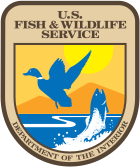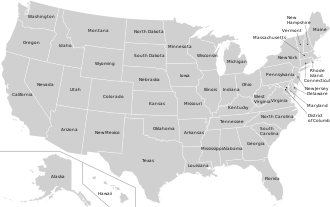
The United States Fish and Wildlife Service is a U.S. federal government agency within the U.S. Department of the Interior which oversees the management of fish, wildlife, and natural habitats in the United States. The mission of the agency is "working with others to conserve, protect, and enhance fish, wildlife, plants and their habitats for the continuing benefit of the American people."

National Wildlife RefugeSystem (NWRS) is a system of protected areas of the United States managed by the United States Fish and Wildlife Service (FWS), an agency within the Department of the Interior. The National Wildlife Refuge System is the system of public lands and waters set aside to conserve America's fish, wildlife, and plants. Since President Theodore Roosevelt designated Florida's Pelican Island National Wildlife Refuge as the first wildlife refuge in 1903, the system has grown to over 568 national wildlife refuges and 38 wetland management districts encompassing about 856,000,000 acres (3,464,109 km2).

The Endangered Species Act of 1973 is the primary law in the United States for protecting and conserving imperiled species. Designed to protect critically imperiled species from extinction as a "consequence of economic growth and development untempered by adequate concern and conservation", the ESA was signed into law by President Richard Nixon on December 28, 1973. The Supreme Court of the United States described it as "the most comprehensive legislation for the preservation of endangered species enacted by any nation". The purposes of the ESA are two-fold: to prevent extinction and to recover species to the point where the law's protections are not needed. It therefore "protect[s] species and the ecosystems upon which they depend" through different mechanisms. For example, section 4 requires the agencies overseeing the Act to designate imperiled species as threatened or endangered. Section 9 prohibits unlawful ‘take,’ of such species, which means to "harass, harm, hunt..." Section 7 directs federal agencies to use their authorities to help conserve listed species. The Act also serves as the enacting legislation to carry out the provisions outlined in The Convention on International Trade in Endangered Species of Wild Fauna and Flora (CITES). The Supreme Court found that "the plain intent of Congress in enacting" the ESA "was to halt and reverse the trend toward species extinction, whatever the cost." The Act is administered by two federal agencies, the United States Fish and Wildlife Service (FWS) and the National Marine Fisheries Service (NMFS). FWS and NMFS have been delegated by the Act with the authority to promulgate any rules and guidelines within the Code of Federal Regulations (CFR) to implement its provisions.
The Migratory Bird Treaty Act of 1918 (MBTA), codified at 16 U.S.C. §§ 703–712, is a United States federal law, first enacted in 1918 to implement the convention for the protection of migratory birds between the United States and Canada. The statute makes it unlawful without a waiver to pursue, hunt, take, capture, kill, or sell nearly 1,100 species of birds listed therein as migratory birds. The statute does not discriminate between live or dead birds and also grants full protection to any bird parts including feathers, eggs, and nests. A March 2020 update of the list increased the number of species to 1,093.

The National Marine Fisheries Service (NMFS), informally known as NOAA Fisheries, is a United States federal agency within the U.S. Department of Commerce's National Oceanic and Atmospheric Administration (NOAA) that is responsible for the stewardship of U.S. national marine resources. It conserves and manages fisheries to promote sustainability and prevent lost economic potential associated with overfishing, declining species, and degraded habitats.
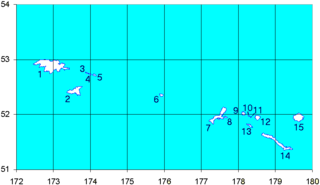
Hawadax Island is an island in the Rat Islands archipelago of the western Aleutian Islands in the U.S. state of Alaska. The island was formerly known as Rat Island until May 2012 when it was renamed Hawadax Island, which is an Aleut name meaning "entry" and "welcome". The island has a land area of 10.3126 sq mi (26.7095 km²) and no permanent population. It is within the Alaska Maritime National Wildlife Refuge. It is 9.3 miles (15 km) in length and 3.1 miles (5 km) in width.

The United States Fish Commission, formally known as the United States Commission of Fish and Fisheries, was an agency of the United States government created in 1871 to investigate, promote, and preserve the fisheries of the United States. In 1903, it was reorganized as the United States Bureau of Fisheries, sometimes referred to as the United States Fisheries Service, which operated until 1940. In 1940, the Bureau of Fisheries was abolished when its personnel and facilities became part of the newly created Fish and Wildlife Service, under the United States Department of the Interior.

The Marine Mammal Protection Act (MMPA) was the first act of the United States Congress to call specifically for an ecosystem approach to wildlife management.

The National Wildlife Refuge System in the United States has a long and distinguished history.

The California Department of Fish and Wildlife (CDFW), formerly known as the California Department of Fish and Game (CDFG), is a state agency under the California Natural Resources Agency. The Department of Fish and Wildlife manages and protects the state's wildlife, wildflowers, trees, mushrooms, algae and native habitats (ecosystems). The department is responsible for regulatory enforcement and management of related recreational, commercial, scientific, and educational uses. The department also prevents illegal poaching.
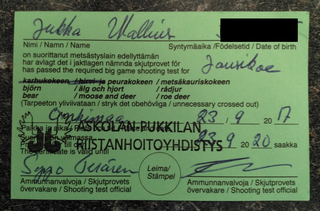
A hunting license or hunting permit is a regulatory or legal mechanism to control hunting, both commercial and recreational. A license specifically made for recreational hunting is sometimes called a game license.

The National Oceanic and Atmospheric Administration Fisheries Office of Law Enforcement is a federal police part of the National Marine Fisheries Service of the National Oceanic and Atmospheric Administration, headquartered in Silver Spring, Maryland. The leadership consists of Director James Landon, Deputy Director Logan Gregory, Assistant Director Todd Dubois, and Budget Chief Milena Seelig.

A conservation officer is a law enforcement officer who protects wildlife and the environment. A conservation officer may also be referred to as an environmental technician/technologist, game warden, park ranger, forest watcher, forest guard, forester, gamekeeper, investigator, wildernessofficer, wildlifeofficer, or wildlife trooper.

The Bald and Golden Eagle Protection Act is a United States federal statute that protects two species of eagle. The bald eagle was chosen as a national emblem of the United States by the Continental Congress of 1782 and was given legal protection by the Bald Eagle Protection Act of 1940. This act was expanded to include the golden eagle in 1962. Since the original Act, the Bald and Golden Eagle Protection Act has been amended several times. It currently prohibits anyone, without a permit issued by the Secretary of the Interior, from "taking" bald eagles. Taking is described to include their parts, nests, or eggs, molesting or disturbing the birds. The Act provides criminal penalties for persons who "take, possess, sell, purchase, barter, offer to sell, purchase or barter, transport, export or import, at any time or any manner, any bald eagle ... [or any golden eagle], alive or dead, or any part, nest, or egg thereof."
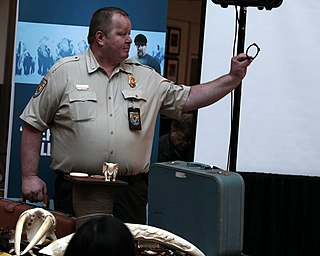
A wildlife inspector is a person empowered by law to protect wildlife.

An endangered species is a species that is very likely to become extinct in the near future, either worldwide or in a particular political jurisdiction. Endangered species may be at risk due to factors such as habitat loss, poaching, and invasive species. The International Union for Conservation of Nature (IUCN) Red List lists the global conservation status of many species, and various other agencies assess the status of species within particular areas. Many nations have laws that protect conservation-reliant species which, for example, forbid hunting, restrict land development, or create protected areas. Some endangered species are the target of extensive conservation efforts such as captive breeding and habitat restoration.

The National Eagle Repository is operated and managed under the Office of Law Enforcement of the United States Fish and Wildlife Service located at the Rocky Mountain Arsenal National Wildlife Refuge outside of Denver, Colorado. It serves as a central location for the receipt, storage, and distribution of bald and golden eagles that have been found dead. Eagles and eagle parts are available only to Native Americans enrolled in federally recognized tribes for use in religious and cultural ceremonies.

James Campbell National Wildlife Refuge is a National Wildlife Refuge on the island of Oʻahu, Hawaii. It was established in 1976 to permanently protect an ecologically-intact unit and to provide habitat for native and migratory fauna and native flora. It established critical habitat for Hawaii's four endangered waterbirds, the ʻalae kea, koloa maoli, ʻalae ʻula, and āeʻo and many migratory seabirds, endangered and native plant species, and the endangered Hawaiian monk seal and green sea turtle. It also provides increased wildlife-dependent public uses and flood control within the refuge and the local community.
The Barrow Duck-In was a civil disobedience event that occurred in Utqiaġvik, Alaska, in the spring of 1961. During the Duck-in, the Iñupiat protested a federal hunting ban on ducks, which threatened their livelihood and rights to food security. The Alaskan North Slope is a remote and rural area, and many residents rely on seasonal bird hunts for sustenance. A series of attempts to regulate Iñupiat subsistence by federal and international entities led to the Duck-in, in which over one-hundred Iñupiaq residents of Utqiaġvik protested waterfowl regulations in the area. The Duck-in is considered a seminal protest, as it had significant influence over future subsistence regulation and Native claims laws in Alaska, such as the Alaska Native Claims Settlement Act (ANCSA).
In hunting, take or taking is a term used in the United States to refer to any action that adversely affects a species, particularly killing individuals of that species, as outlined by the United States Endangered Species Act of 1973. Although "taking" most commonly refers to the act of killing animals in a hunting context, its definition can also extend to include harassing, harming, pursuing, hunting, shooting, wounding, trapping, capturing, and collecting any plant or animal. The definition of take can also further extend to comprise the indirect harming of a species via modification of its habitat (see below§ Legal Definition of Take).
